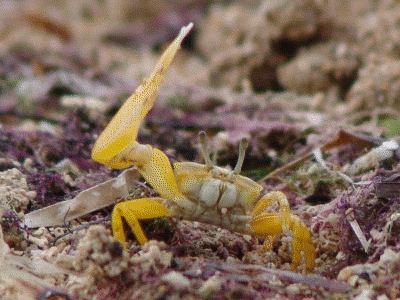 |
| West of Matava, Kadavu; March 16, 2012 (Fiji Beachcombing series No.7) : Metal lid labelled "Tokin Mathematical Instrument Box," clam, coral, crab claw, Nerites (Nerita sp.), 'mudstone,' unidentified shell, coconut seed (Cocos nucifera). |
This is the post where you finally get to hear all about the fiddler crabs! I know you've been waiting for it, but first, a pretty picture:
This morning I set off to explore the shore to the west of Matava. Off on the other side of that point is the village of Kadavu Koro, where many of the people who work at Matava live. Look closely at the shore in the photo above.
At low tide, this is the local highway. There's a path through the forest, too, but this one must be easier to travel. Especially barefoot (there's only one set of prints with shoes on.) Now look a little closer. Can you see all the holes, and maybe a few bright yellow dots?
This is Uca perplexa (or it might be Uca lactea), a type of fiddler crab. There are hundreds of them concentrated in patches like this, and hundreds more scattered more thinly across the mudflats. When you see a big patch like this, their behavior is even more dramatic. They stand in one place waving their claws something like this:
 | |||||||||||||||||||||||||||||||||||
| (GIF courtesy of Wikipedia - not my work!) |
Except that the guys I saw (yeah, they're guys; the females don't have
the big claw) usually hovered halfway out of their holes, like this...
...to do their dance. Some of the locals would sit on the seawall watching them. It was hypnotic. One of the guys said that it always seemed about to resolve into a pattern, but never did. You could never tell what the next step in the dance would be.
This one's a female.
And very beautiful. Some of the designs looked like cryptic writing or maze designs.
It took me a while to figure this one out. I think the grey balls are sediment dug out from the lower layers of sand, while the brown balls are the top layer. Further deductions: the grey sand is probably anaerobic (or less aerobic, at any rate) and was probably excavated when the crab dug the tunnel. So let me ask you - when you go beachcombing, do you find yourself squatting in unbecoming postures with your chin propped on your hand as you stare at small holes and try to decipher unfamiliar patterns? To think I used to just hunt for sea glass!
One last bit abut the fiddler crabs: a video showing sand-bubbler crabs making these sand balls (different species of crab, same basic strategy.) The video isn't mine, it's by Matthew Davidson, courtesy of YouTube.
Other cool critters I saw:
Hermit crabs, mudskippers, a rooster,
this weird thing that probably opens up like an anemone when under water,
and molluscs that glue themselves rather thoroughly to the rocks (many rocks are completely encrusted with these, like barnacles. They are sharp like barnacles, too. Ow.) There were also small black biting bugs, very like blackflies but neither so plentiful nor so aggressive.
And when I got back, George had brought a small boa constrictor to visit. George is very thoughtful that way.
This is Candoia bibroni, the Pacific Boa
Isn't she cute?















No comments:
Post a Comment